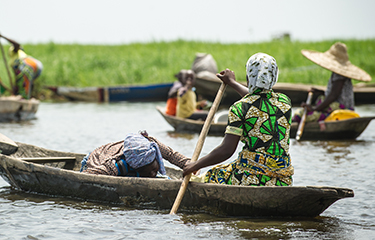The COVID-19 pandemic has shaken the entire seafood industry. Demand for fresh seafood has plummeted as restaurants, hotels, and catering businesses shutter. And trade has faltered as transportation restrictions prevent supply chains from moving product.
But while businesses in the developed world can apply for social safety provisions and major seafood companies' balance sheets give them a fighting chance to weather the storm, small-scale fishermen face severe risk. Especially in the developing world, where a day's catch buys that night's meal, fishermen’s prospects are bleak.
"Fishers and fish workers — particularly women who operate in the post-harvest sector — face the biggest challenges with loss of income, lower wages, [and] risk of contagion," Manuel Barange, director of the Fisheries and Aquaculture Department at the Food and Agriculture Organization (FAO) of the United Nations, told SeafoodSource. "All of this can have impacts on food and livelihood security of the most vulnerable sectors of society, especially in low income countries and small island developing states."
FAO published a policy brief about the impact of COVID-19 on fisheries and aquaculture earlier this month.
The fallout of the pandemic has evolved as the virus has spread across the world and trends change week-to-week as more countries go into lockdown. Some of the first impacts were in exports of fish and seafood as international markets closed, starting with China. The fresh fish and shellfish sector took a major hit when hotels, restaurants, and caterers closed down.
Transportation and logistical challenges linked to lockdowns increased costs and delays, affecting industries such as salmon. Tuna fishermen and companies suffered as ports closed, making it difficult to change crews.
Of course, it hasn’t all been suffering: in some countries, canned and processed seafood has flown off store shelves as shoppers buy in panic and stock up on nonperishable foods. Domestic producers in some countries have benefited as consumers turn toward local fish because of inaccurate fears over the health risks of imported fish. Novel distribution methods have arisen, allowing consumers to buy seafood boxes online.
While major seafood companies in developed countries cope with falling demand, disrupted supply chains, and limited cold storage capacity, many are also buffered from the worst of the crisis by economic aid packages and social protection measures. For small-scale fishermen, the consequences of the pandemic are more severe.
Social distancing requirements prevent some small-scale fishermen from going out on the water altogether since their boats are too small to abide by the rules. Many are also unable to sell their products, since informal beach markets are often the first point of sale.
"Given the restrictions of movement in many countries, these as well as other types of markets have ceased to exist and the fisher cannot gain an income that would allow them to buy other food items for their families," Nicole Franz, a FAO fishery officer for small-scale fisheries, told SeafoodSource.
Small-scale fishermen also lack access to cold storage, so the risk is that their fish goes to waste if it's not sold, causing unnecessary impacts on the environment as fish are killed but not actually eaten. In developing countries, fishermen and post-harvest workers often lack access to social protections; many are unregistered and are part of the informal workforce, with little or no access to relief or aid — or health services.
"Access to health services is in many cases already an issue in non-pandemic times, despite the higher exposure of fishing communities to diseases such as malaria and dengue close to inland waters, or even HIV/AIDS," Franz said. "So in times of COVID-19, this is even more of an issue."
The sector has demonstrated resilience, though. Franz described an auction market in India where the ground was marked to help visitors comply with social distancing guidelines. A South African NGO, Abalobi, has seen an uptick in local fishers seeking to join a platform dedicated to responsible sourcing so they can market their fish. Multiple groups are collecting surveys and releasing information on small-scale fisheries' adaptations.
"Small-scale fishing communities are often off the radar for policymakers, and their social, economic, and political marginalization in a situation like this pandemic puts a serious threat to the livelihoods of these communities that provide food for millions of people," Franz said.
Some small-scale fishermen are adapting by changing fishing gears, targeting different species, or selling their products domestically, but not all of them are able to do so, Barange said, especially since demand is only so great in domestic markets.
In the short-term, Barange predicts multiple emerging sources of pandemic-driven disruptions. Labor shortages could result from travel restrictions. Aquaculture could suffer from lack of feed, seed, and vaccines, while fishing could suffer from lack of bait, ice, and gear. Limited transportation services could induce competition among sectors.
"The biggest uncertainty is not only the duration of the effects of the pandemic, but how long the adjustments will last after the pandemic is over," Barange said. "Will seafood demand experience a fast or slow recovery? Will companies that have adjusted to domestic sourcing to bypass trade concerns keep the same footprint in the future? If the economic hardship continues, will the industry experience significant consolidation?"
The industry might also be able to use the disruptions as an opportunity to improve traceability and business practices.
"Every challenge will open some opportunities," Barange said.
Photo courtesy of Anton_Ivanov/Shutterstock







